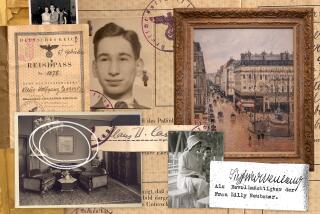Trove of paintings has works looted by Nazis, masterpieces
- Share via
LONDON -- A massive cache of art discovered in the Munich apartment of an elderly recluse contains hitherto-unknown works by famous artists as well as pieces believed confiscated by the Nazis in their persecution of Jews or their campaign against “degenerate art,” German prosecutors said Tuesday.
Some of the 1,400 items are known masterpieces believed destroyed during World War II; others are new to art historians, such as a self-portrait by painter Otto Dix. The hoard boasts works by giants of the 20th century -- Pablo Picasso, Henri Matisse, Pierre-Auguste Renoir, Marc Chagall, Max Liebermann -- but also some older pieces, including a painting from the 16th century.
“When you stand in front of works and see these long-lost works in good condition that were thought to have been destroyed, that is such a happy feeling,” said Meike Hoffmann, an art expert at the Free University of Berlin who has been examining the hoard. “The pictures are of extraordinary quality and are of huge scientific value. Many works were not known before.”
In all, authorities seized 121 framed works and 1,285 unframed works in good condition from the crowded apartment of Cornelius Gurlitt, the son of a well-known Nazi-era art dealer, said Reinhard Nemetz, a prosecutor in the southern German city of Augsburg, near Munich.
Nemetz said there was “concrete evidence” that some of the works had been plundered or confiscated by the Nazis. Yet he said that police are not in touch with Gurlitt and have not arrested him, though the 80-year-old is under investigation for possible tax evasion and embezzlement.
“We currently have no contact with the suspect. But there is no urgent suspicion that would justify a warrant,” Nemetz told reporters.
The raid on Gurlitt’s flat, the culmination of a long investigation, occurred over a three-day period, from Feb. 28 to March 2, 2012, Nemetz said. That is a year later than was reported by the German magazine Focus, which broke the story of the remarkable discovery this past weekend.
Since word of the cache emerged, advocates of returning art looted during the war have criticized German officials for keeping quiet about it for so long and failing to publish an inventory as quickly as possible, so that heirs of the original owners could reclaim what was stolen from them.
Nemetz said that keeping the works safe was crucial and that security could have been compromised by a media frenzy surrounding news of their discovery.
“It is totally counterproductive for us to go public with this case,” he said. “We don’t want to keep the pictures. The pictures are not going to be put up in my office.”
He added: “Our primary goal is to investigate whether there has been a crime. It is by no means easy to find the rightful owners, particularly when we are talking about more than 1,400 paintings.”
Gurlitt came to the notice of German authorities during a customs inspection of passengers aboard a train from Zurich, Switzerland, to Munich in September 2010. Focus reported that he had more than $12,000 in cash on him, which was within the legal limit but which aroused suspicion.
His father, Hildebrand Gurlitt, was a noted art dealer appointed by the Nazi regime to help it collect and dispose of artworks, including some forcibly taken from Jewish families. The elder Gurlitt died in 1956, having told Allied investigators after the war that rumors of his owning a trove of art were false and that whatever holdings he had were destroyed in the bombing of Dresden, Germany.
ALSO:
Germany raid yields hundreds of artworks
Military, CIA compelled medics to abuse detainees, report says
Iranian Revolutionary Guard commander reported killed in Syria
More to Read
Sign up for Essential California
The most important California stories and recommendations in your inbox every morning.
You may occasionally receive promotional content from the Los Angeles Times.











